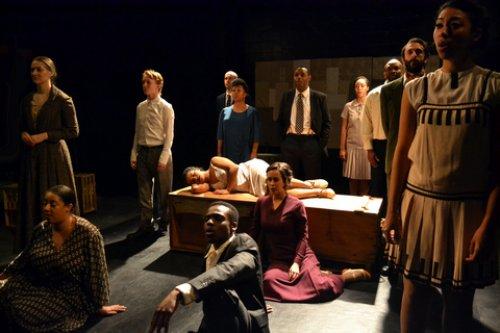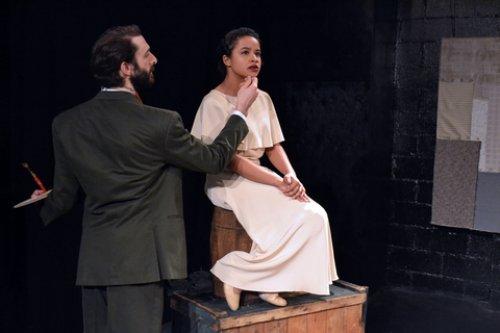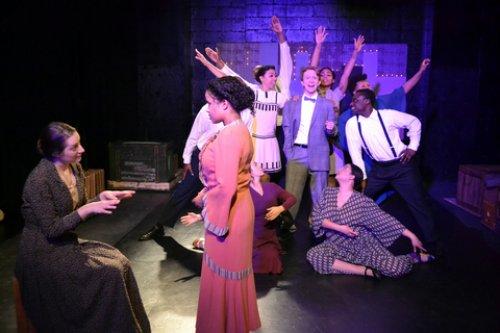Quicksand
Ambitious, epical staging of Nella Larsen’s first novel about the journey of a biracial beauty who discovers that she can’t fit in anywhere in either America or Europe.

Gabrielle Laurendine (asleep on bed) and cast of “Quicksand” from the novel by Nella Larsen (Photo credit: Anaïs Koivisto)
[avatar user=”Victor Gluck” size=”96″ align=”left” ] Victor Gluck, Editor-in-Chief[/avatar]Quicksand, Nella Larsen’s 1928 award-winning first novel, has been given an ambitious, epical stage adaptation by Everyday Inferno Theatre Company working out of the IRT Theater. While Regina Robbins’ script for this Harlem Renaissance literary work basically is an assigning of the text of the novel to a company of 13 actors, it is the work of director Anaïs Koivisto who makes this swirling production feel adventurous in creating both a community and a specific world. EITC’s mission statement is to create “adventurous theatrical productions of new or rarely produced texts that tell women’s stories in a unique, entertaining, and accessible manner,” and this lives up to its goal.
The production, however, does have its weaknesses. The busy set design by Tekla Monson requires the continual moving around of boxes and crates for each scene, many of which could have been more quickly achieved with simple projections. Each member of the cast of 13 plays many roles in this panoramic story but they are not equally suited to all of them. If you are familiar with the novel, you will be thrown by many of the character interpretations that are contrary to Larsen’s depictions in the novel, which may be the choice of the playwright or the director. Asia-Anansi McCallum’s costumes are often unsuitable for various characters and particularly the 1920’s period.
Larsen’s story is extremely autobiographical; she, like her heroine Helga Crane, a light skinned college educated woman, had a Danish mother and a Black West Indian father who disappeared from her life soon after she was born. Early orphaned, Larsen, like Helga, had trouble finding a milieu in which she felt accepted. The sections of the play like the novel show us Helga’s failures in academic, vocational, social, artistic, literary and religious circles. When we first meet Helga she has been teaching at Naxos, an all-Black college (like Tuskegee Institute where Larsen worked briefly) and is engaged to fellow teacher James Vayle whom she does not love. However, on this day she had decided to resign as she has had enough of the hypocrisy of teaching the students to know their place in society. She has a meeting with Dr. Robert Anderson, the school head, who is sympathetic but can’t convince her to remain.
She leaves for Chicago to see her white Uncle Peter who had paid for her education, only to discover that he has remarried to a very prejudiced woman who tells her not to call again. Her job search finds her unqualified for anything without references or experience, and teaching is out after her abandoning her position mid-term. Just as she is about to become destitute, she is offered a job as a companion to Mrs. Hayes-Rore, a refined lecturer on the race problem, who is traveling to New York. She introduces Helga to her niece, the widowed Anne Gray, a fixture of Harlem high society. They hit it off, Helga moves in with her and becomes popular in her social and literary circle, as well as taking a desk job that Mrs. Hayes-Rore obtains for her that gives her financial stability.

Michael Quattrone and Gabrielle Laurendine in a scene from “Quicksand” based on the novel by Nella Larsen (Photo credit: Anaïs Koivisto)
Just at the time she is growing bored with her new life, her Uncle Peter sends a check for what would have been her future inheritance which makes it possible for her to visit her Aunt Katrina and Uncle Paul in Copenhagen. There she is wined, dined and lionized by their wealthy friends. Dashing and famous artist Axel Olson asks to paint her portrait, and she discovers that she is just considered an exotic, leading to her turning Axel down when he proposes. When Anne sends a wedding invitation for her remarriage, she decides to return to America if only briefly. In New York, Helga is reunited with James Vayle and Dr. Anderson but doesn’t find either of them to her liking. Continuing her search, she begins to descend the ladder just like Edith Wharton’s Lily Bart in The House of Mirth. She ultimately finds herself in Alabama where things are not much better and possibly much worse.
The milieu and setting is fascinating as it has not often been put on the New York stage in recent times. Playwright Robbins has cleverly incorporated both musical and cultural landmarks: references to W.E.B. Du Bois, E.M. Forster’s A Passage to India, Irving Berlin’s “April Showers” as sung by Al Jolson, a scene from Eugene O’Neill’s The Emperor Jones with Paul Robeson, Jessie Redmon Fauset’s There is Confusion, and F. Scott Fitzgerald’s The Great Gatsby. Director Koivisto makes clever use of her cast as an ensemble of voices to create the various communities Helga joins with dialogue, song and dance (choreographed by Allison Beler.) However, at two hours and 50 minutes, the play is too long, suggesting too much was kept from the novel, rather than transforming the material into a stage play. Also there is no arc in Helga’s journey: while in the novel, each section built toward her disillusionment in that locale, here it seems to be a sudden decision every time.
The acting is variable with some idiosyncratic interpretations which put a new slant on the material. Gabrielle Laurendine is attractive as the heroine Helga but she is decidedly callow, rather than urbane as she is in the novel. Malloree Hill is fine as both the bigoted wife of her Uncle Peter in Chicago and her doting Aunt Katrina in Copenhagen anxious to marry her off. However, the dowdy clothes she has been given undercut her role as a social climber. Dressed in a ridiculous black and white mini-dress as a woman of taste and breeding in the Harlem Renaissance, Marissa Stewart as Anne is made to come on to Helga when they first meet and then seems to go on a soap box whenever she makes a pronouncement, rather than the retiring, refined woman Larsen depicted.
Veronique Jeanmarie captures the satire inherent in Mrs. Hayes-Rore, the authority on the race problem. Monica Rodrigues is very different as Helga’s mother Karen and as Audrey, an envied Black beauty who has gotten a reputation for trying to pass as white. Synead Nichols is outstanding as Sary Jones in the Alabama section and as several other characters along the way.

Malloree Hill and Gabrielle Laurendine (foreground) and cast in a scene from “Quicksand” based on the novel by Nella Larsen (Photo credit: Anaïs Koivisto)
The male actors are more problematic. Michael Quattrone completely misses the boat by making the dashing and sophisticated artist Axel Olson stiff, pompous and awkward, not the man who is the toast of the town. Tyler Johnson is believably quirky as James Vayle, Helga’s first fiancé. Tommy Coleman as the distinguished Dr. Anderson leaves it mostly up to others to describe his character traits. However, as the Reverend Green, Michael Anthony Jones does not give him much of a personality other than initially coming across as a Good Samaritan. Chris Wight makes the Chicago Uncle Peter an apologetic presence while his dilettantish Copenhagen Uncle Paul is almost comic. Sam Ogilvie as several characters including Al Jolson to Smithers in The Emperor Jones seems much too young for his roles.
While Tekla Monson’s setting for the many scenes is suitable, it is often unattractive and lacking in atmosphere. A collage on the back wall which at times resembles a city skyline is particularly distracting. The costumes by Asia-Anansi McCallum define the characters only part of the time. Grace Oberhofer’s music and sound design goes a long way to creating the ambiance required. The lighting by Gilbert “Lucky” Pearto is nothing more than serviceable.
The Everyday Inferno Theatre Company’s adaptation of Nella Larsen’s Quicksand is a fascinating director’s project from Anaïs Koivisto, bringing to life a period of the 1920’s in African American history that is rarely dramatized. It also deals with the thorny question of being biracial in American society which in the twenties seems to have had no place for these people. While Regina Robbins’ adaptation is faithful to the original novel, it needs a bit of trimming and less emulative handling for the stage. Nevertheless, Quicksand is an impressive, immersive production and worthy of your time.
Quicksand (through December 15, 2018)
Everyday Inferno Theatre Company
IRT Theater, 154 Christopher Street, in Manhattan
For tickets, visit http://www.everydayinferno.com
Running time: two hours and 50 minutes with one intermission






Leave a comment